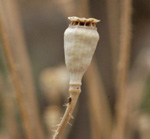

Poppy, Papaver rhoeas, flower opening, near Ajlon, Jordan
SPRING IN THE HOLY LAND COMES early. By February, the hills above the Jordan Valley and elsewhere are filled with riotous masses of wildflowers in a spectacular display. In fact, the hills above the Ghor, the Jordan Valley, have one of the most diverse floras per unit area on our planet. A plant that particularly stands out here is the red poppy.
This poppy may be the plant referred to by the Apostle Peter: “All men are like grass, and all their glory is like the flowers of the field; the grass withers and the flowers fall” (I Peter 1:24, NIV). This fleeting bloom is probably the common poppy, Papaver rhoeas.
Each poppy plant has a single flower that rises from a prominent bud. Poppies are distinctive in having petals crinkled in the bud, resembling crepe paper. As they open, they smooth out, and within a day, fall off the plant, leaving the ground littered with petals that soon dry and lose their color in the hot sun. Poppy fruits contain abundant small seeds dispensed through numerous pores.
Superficially, poppy may be confused with the common anemone, Anemone coronaria. However, the poppy is annual, while the anemone is perennial.
The Quran likens the brevity of life to a field that soon turns to stubble: “Present to them the example of the life of this world so like the water We send down from the skies that mingles with the earth to nourish its vegetation, which then on the morrow turns to stubble and is blown away by the wind. God has power over every thing” (Sura 18:45, Ali). The rich man had boasted to his poorer neighbor, only to find that it was all in vain when God was left out.

Red poppies with the distinctive black iris, Iris nigricans, the national flower of Jordan, near Jerash, Jordan.

The poppy flower remains open for less than a day and by evening the petals are gone. Jebel Abdel Aziz, northern Mesopotamia, Syria, in May.

The capsule of the poppy has a distinctive “salt shaker” construction. Sair, near Hebron, in May.
Thus in both holy books, the fleeting nature of human life is likened to the vegetation that is vibrant one day but soon passes. Only what is eternal will last.